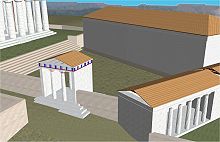Chalet
In general, the Chalkotheke (from the Greek χάλκεος “iron”, “brazen”) refers to a building in a temple or temple district that is used to store metal consecration gifts.
The best known is the chalet on the Athens Acropolis , which is represented by inscriptions from the 4th century BC. Is occupied. A decree stipulates the listing of all objects kept in the chalet and the installation of the stele bearing this list in front of the chalet.
The remains of buildings discovered east of the sanctuary of Artemis Brauronia are believed to be able to be assigned to the chalet. Only the limestone foundations of the building and rock workings to accommodate the foundations remain. The approximately 43 meters long and 14 meters wide building stood in front of the southern wall of the Acropolis. For part of the building, a column hall about 4.50 meters deep in front, some steps of the outside staircase, which were located on its northwest corner and led to the building level of the Parthenon , were destroyed and built over. The building itself is therefore built around the same time as the Parthenon around the middle of the 5th century BC. While the hypostyle hall is an addition of the early 4th century BC. Is. The building appears to have been extensively restored in Roman times. Numerous workpieces from this restoration, which due to their dimensions can only be connected to the chalet, were found scattered on the Acropolis.
literature
- Maria S. Brouscaris: The monuments of the Acropolis . Athens 1978, pp. 56-57.
- Lambert Schneider, Christoph Höcker: The Acropolis of Athens. A history of art and culture. Primus-verlag, Darmstadt 2001. p. 189
Individual evidence
- ^ Inscriptiones Graecae II² 120, 1430.
- ^ Inscriptiones Graecae II² 120.
